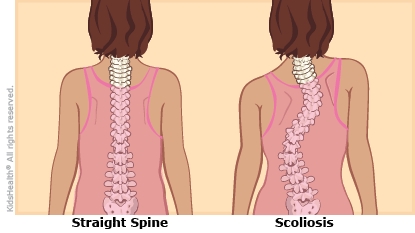Caring for Your Child With Scoliosis

When a child has scoliosis, the spine curves in the shape of an "S" or a "C" instead of going straight up and down. If the curve is big or causes problems, the health care professional may want to treat it.


At today's visit, the health care professional diagnosed your child with scoliosis. The orthopedic specialist will decide on the best treatment after looking at the shape of the spine on an X-ray.
If your child's scoliosis is mild, it means the curve is small and isn't causing problems right now. A curve can get bigger as kids grow, so the health care professional may want to check your child's back every few months.
If the curve is bigger, the health care professional may want your child to wear a brace. Wearing a brace correctly can stop the spine from curving more.
Some kids with scoliosis need surgery to correct the curve. This surgery is called spinal fusion. It helps kids avoid problems like back pain later in life, breathing trouble, or heart problems. During spinal fusion, doctors put small pieces of bone, metal rods, and screws into the spine to straighten it. After a full recovery, kids can play sports again and do all the activities that they enjoyed doing before surgery.

-
Go to follow-up appointments so the health care professional can check your child's spine.
-
If your child needs to wear a brace, follow the health care professional's instructions for how and when to wear it. Wearing the brace correctly for as long as it's recommended might help kids avoid the need for surgery.
-
Encourage your child to play sports or join in other favorite activities, unless your health care professional says not to.
-
Teens may feel frustrated and upset about having scoliosis, especially if they need to wear a brace to school. Listen to your child and be supportive. Online or in-person support groups can let your child talk to other people who are going through the same thing.

-
Your child develops pain.
-
Your child's scoliosis looks worse to you.
-
You have questions about how or when your child should wear a brace.